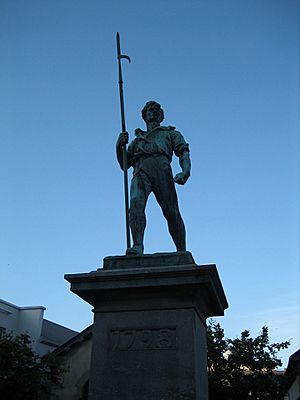The Rising of the Moon facts for kids
"The Rising of the Moon" is a famous Irish ballad. It tells the story of a battle. This battle happened during the Irish Rebellion of 1798. The song is about the Society of United Irishmen, led by Wolfe Tone. They fought against British forces.
Contents
What is "The Rising of the Moon" About?
This song describes a secret plan. The singer hears that "pikes must be together at the rising of the moon." This means rebels should gather their weapons. They plan to start a rebellion.
The song tells how the pikemen gather. But they are defeated by the government's soldiers. Even though they lose, the song offers hope. It says others will "follow in their footsteps." This means new rebels will rise up again. They will fight against British rule in Ireland.
Where Did the Song Come From?
The tune for "The Rising of the Moon" is not new. It uses the melody of another Irish ballad. That song is called "The Wearing of the Green".
The song was first printed in 1866. It was part of a collection by John Keegan Casey. His book was called A Wreath of Shamrocks. John Keegan Casey (1846–1870) wrote the words. He was known as the "Fenian Poet". He based the poem on a failed uprising in 1798. This event happened in Granard, County Longford.
The song has been around since about 1865. The first time it was definitely printed was in 1867.
Why Was This Song Important?
The ballad talks about the start of the Irish Rebellion of 1798. It shows how the United Irish rebels shared their call to fight. The song gave a feeling of hope and excitement. This was for a rebellion that did not succeed.
This hope was meant to inspire new rebels. They were getting ready for another uprising. This was the Fenian Rising in 1867. That rebellion also did not succeed.
Many different versions of the song's words have been printed. In the late 1800s, it was also printed on large sheets of paper. These were called broadsides.
How Popular is the Song Today?
"The Rising of the Moon" is still very popular. Its tune is well-known in Ireland today. It is often taught in schools. You can hear it regularly at official events and sports games.
Many musicians have recorded the song. These include The Dubliners, The Clancy Brothers, and The High Kings. Other artists like Tommy Makem, Shane MacGowan, Tia Blake, Barry McGuire, and Peter, Paul and Mary have also sung it.


